Russell Spanner was a Canadian designer who contributed to residential furniture designs in the 1950s. Some of his most famous works are the Ruspan Line, Catalina and Pasadena.
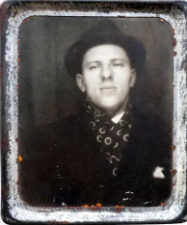
Image source:https://retrorenovation.com/wp-content/uploads/2014/04/Russell-Spanner-photo02.jpg
Russell Spanner’s Origins
Russell Spanner was born inTorontoon July 18, 1916. As a student he pursuedarchitectural draftingand was also an accomplished amateurwrestler, winning a City of Toronto championship. In fact, he was known to test the strength of his designs by jumping on them and throwing them across the factory floor.
Spanner’s family was in the business of manufacturing battery separators but by the later 1930s, due to a decrease in demands, it diversified intomanufacturing other wooden items, including table-tennis tables, and “Breakfast Room Furniture”.
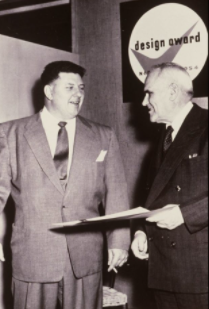
Image source:https://retrorenovation.com/wp-content/uploads/2014/04/Russell-Spanner-NDC-Award-1954.jpg
Working in the Family Business
Despite a stormy relationship with his father Albion Spanner, Russell joined the family business in 1941, working as the foreman of the night shift. After taking acourse in factory management他想出许多想法来提高植物三维ency, but met opposition from his father and was never able to realize them.
In the summer of 1945, Russell was reassigned. He was now overseeing the production of furniture and was verykeen to start developing his own designs, rejecting the Art Déco styling of the “breakfast room furniture”. However, he wasn’t truly able to spread his creative wings until 1948, when his father Albion retired and Russell became the plant foreman.
After his father’s death, the company was in a precarious financial position. Therefore, in 1955, the family’s factory moved near Dufferin and Lawrence and started selling directly to customers, offering lower prices than the downtown department stores.
By the mid-fifties, Spanner furniture design began to be influenced by the wildly popularScandinavian style, and the distinctive look of Russell’s earlier designs was diluted.
In 1963, the family’s company was dissolved, but by that time Russell Spanner had already left the family business to be the plant manager forOntario Store Fixtures, where he continued to work until his death in 1974 at the age of 58.
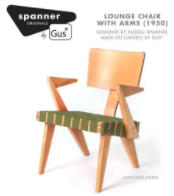
Image source:https://retrorenovation.com/wp-content/uploads/2014/04/lounge-chair-with-arms.jpg
A Legacy
Despite the short time span of his career, Russell Spanner’s furniture continues to be popular and some re-finished pieces of his, still grace the homes of a few fortunate Toronto residents. With itsquirky,space-ageand yet completelyfunctionalfeatures, Spanner’s work appeals to many of those people who feel nostalgic for the fifties, whether or not they actually lived through the decade.
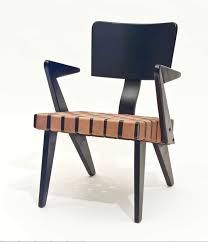
image source:https://commons.wikimedia.org/wiki/File:Russell_Spanner-Lounge_Chair_With_Arms.png
Design and Aesthetic
Spanner’s designs includeddiningandlounge chairs,tables, andmodular storage units. To realize them, he utilized innovative manufacturing techniques such ascurvedplywoodandnon-upholstered,woven-web seating. Many of the designs reused components and shared consistent proportions, which gave his work a characteristic aesthetic.
Among his three residential furniture lines (Ruspan Originals, Catalina, and Pasadena) theLounge Chair with Armshas been described as the “best-known and most desirable” design.
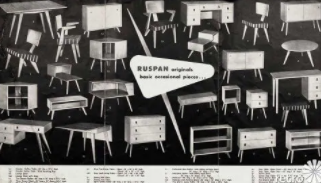
Image source:https://retrorenovation.com/wp-content/uploads/2014/04/RuspanOriginals-brochure.jpg
The designer’s most famous works
Ruspan Originals
TheRuspan Linewas characterized by asimple,stripped-down look,boxyand designed to amodular standardso that one could build up a collection of pieces that would work together. The splayed andtapered legsof the tables, chairs and side pieces lend afuturistic airto the furniture, and the curved plywood chair backs recall the modernity of airplane wings. The wood came in a variety of finishes, from light to black, and the canvas webbing for the chair seats was available in cheerful red, green, black, blue, yellow or grey. Ruspan furniture could not have looked more different from the heavy, upholstered and carved furniture of the forties.
Catalina
In 1952, Spanner introduced hisCalifornia-inspired Catalina Line, which differed from the Ruspan Originals in that the chair seats were made of填充乙烯基rather than webbing. The chairs also hadtwo splatsinstead of one, and abutterfly-shaped back.
Pasadena
1953 saw the release of thePasadena Line, which featuredcork topsincorporated into the designs, and arounder, less ‘space-age’ appearance.
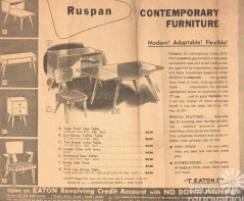
Image source:https://retrorenovation.com/wp-content/uploads/2014/04/vintage-furniture-advertisement-1950s.jpg
Info sources:
https://www.toronto.ca/city-government/accountability-operations-customer-service/access-city-information-or-records/city-of-toronto-archives/whats-online/web-exhibits/space-age-furniture-lands-in-toronto/
https://en.wikipedia.org/wiki/Russell_Spanner
https://gusmodern.com/products/spanner-lounge-chair-with-arms
